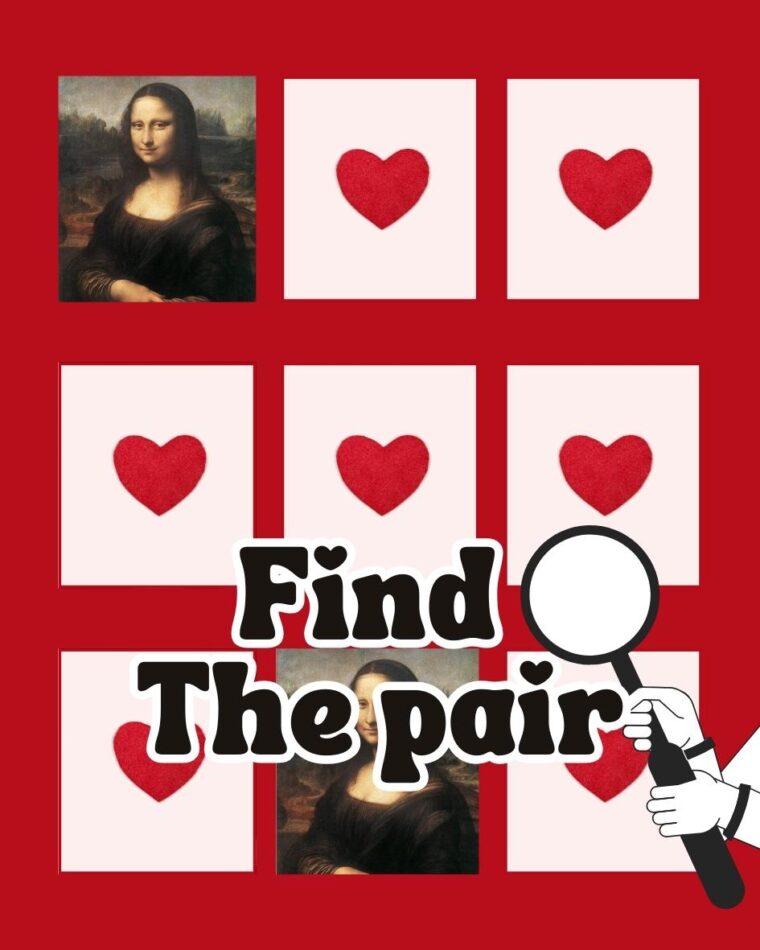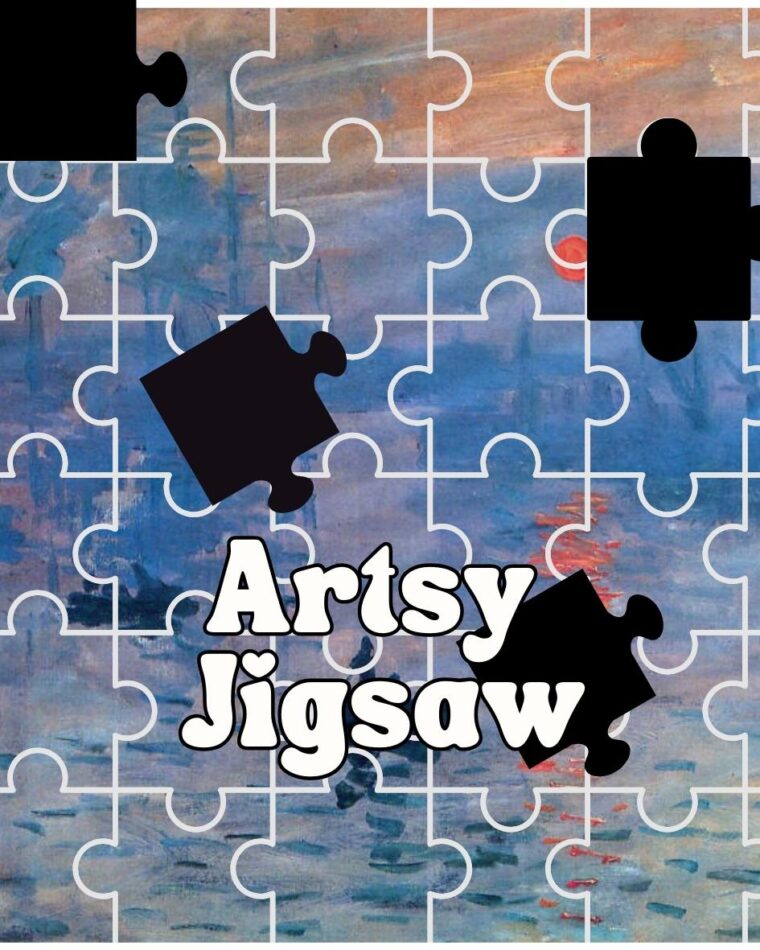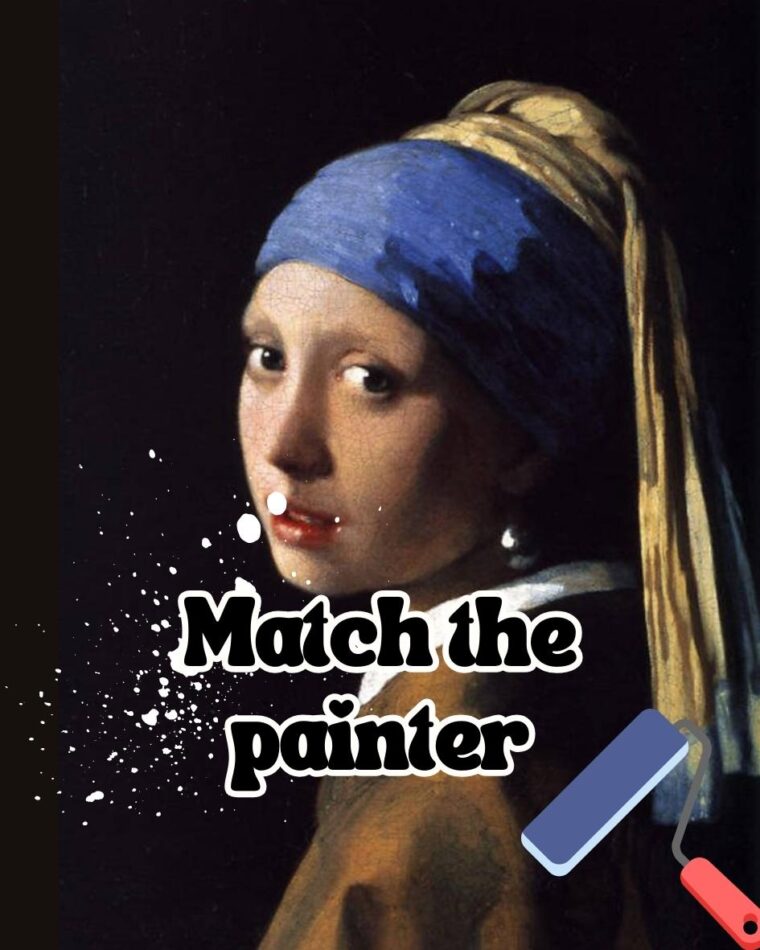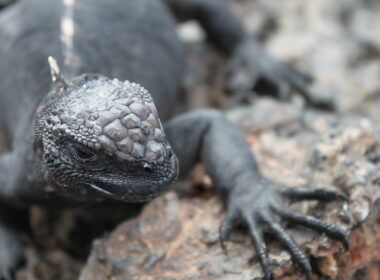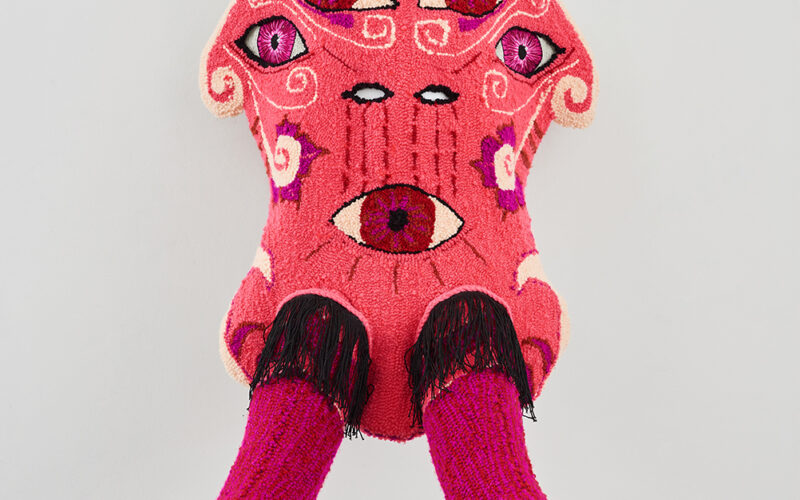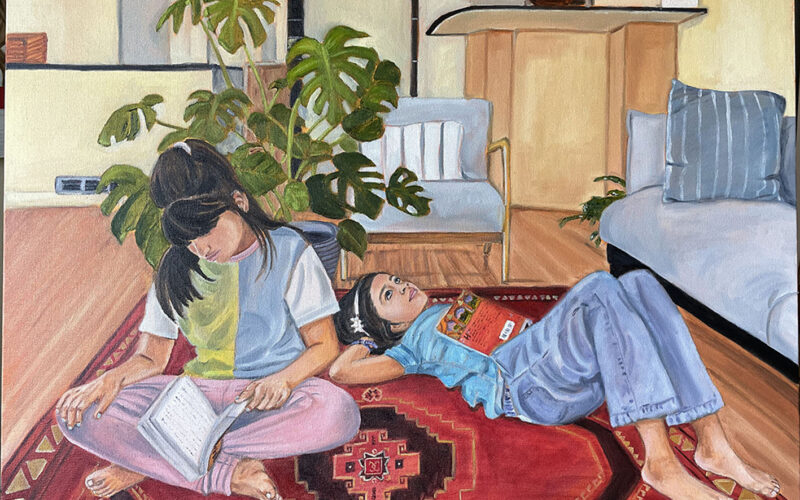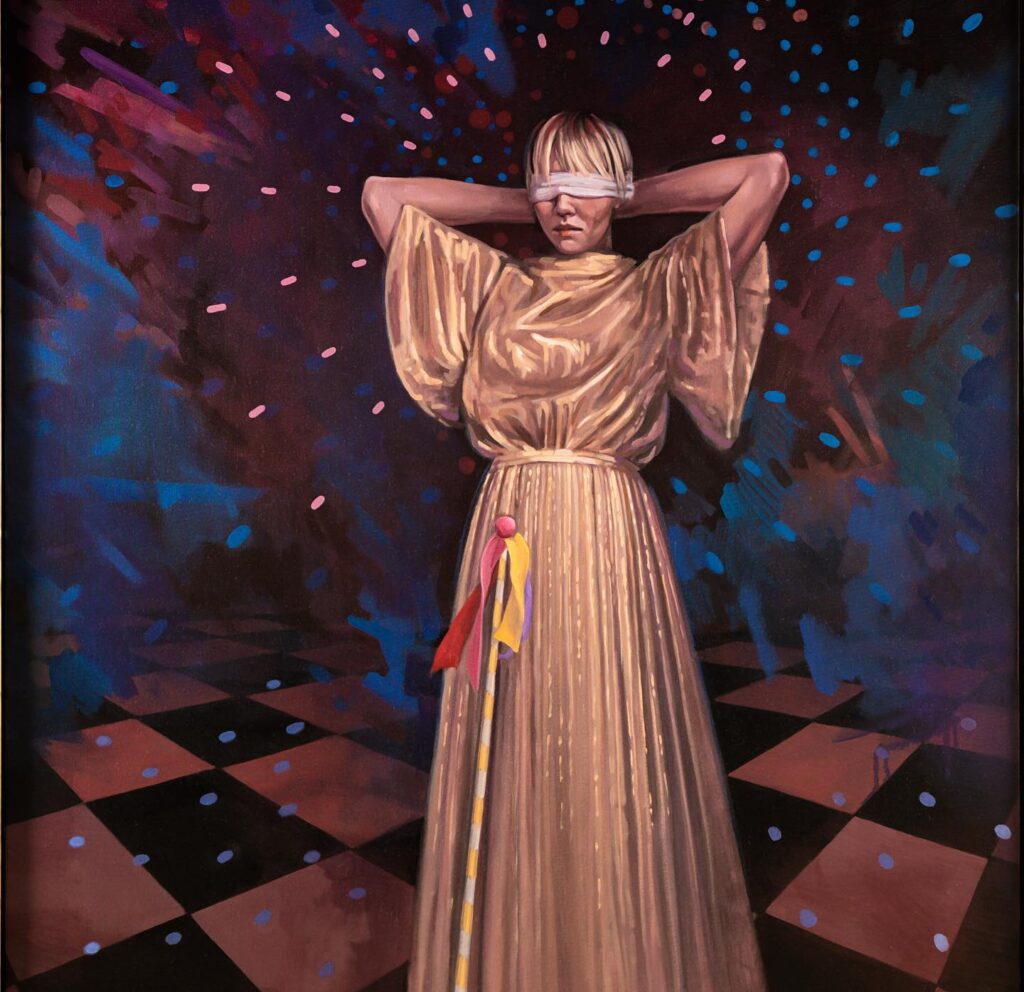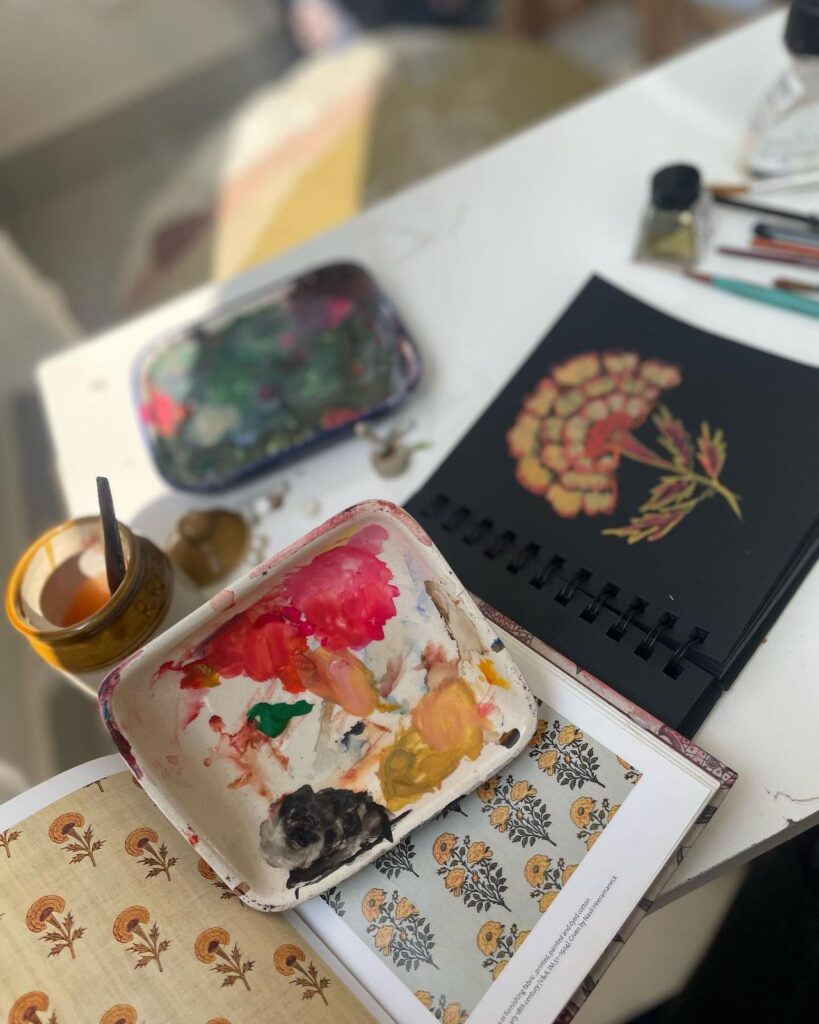

Watch & Listen to this podcast Episode.
On this week’s Arts to Hearts Podcast, we have Liz Andrews as our guest, a passionate artist, curator, and leader in the arts. In this episode, she shares her journey through the art world and her commitment to social justice. As the Executive Director of the Spelman College Museum of Fine Art, Liz discusses how she uses art to reclaim cultural identities, challenge historical narratives, and uplift underrepresented voices.
Throughout the episode, Liz reflects on her experiences curating impactful exhibitions, from showcasing the rich narratives of Black American Portraits to introducing contemporary pieces that challenge conventional perspectives. She discusses the importance of vulnerability in creating and curating art, highlighting how artists like Bisa Butler and Lava Thomas use their work to express complex emotions and reclaim lost histories.
We also dive into the challenges Larissa faced in making such a big move and how she Liz also discusses the unique role that museums play in making art accessible to everyone and elevating voices that are often unheard. She emphasizes the power of museums as places to display art and spaces where stories are told, identities are celebrated, and cultural conversations are sparked. From her own experience, she shares how curating at Spelman has allowed her to blend fine art with deeper cultural storytelling, ensuring these narratives reach wider audiences.
Don’t miss out on this insightful conversation as Liz Andrews illuminates the resilience of cultural identities and the power of art to preserve history and inspire future generations. Tune in to this week’s full episode!
| Timestamp | Summary |
|---|---|
| 0:00 | Starting the Conversation |
| 0:24 | Passion for Arts Administration |
| 1:10 | Neglecting Self as an Artist |
| 2:26 | Balancing Multiple Roles as Women in Art |
| 3:19 | Vulnerability in Art and Curating |
| 4:05 | Harmony Rosales Exhibition |
| 7:42 | Challenges of Exhibiting Non-Christian Art at Christian Schools |
| 9:02 | Impact of Colonialism on Culture |
| 10:19 | Indian Mythology and Identity Restoration |
| 12:00 | Westernization of Yoga |
| 14:08 | Authentic Yoga Practices in India |
| 15:17 | Claiming Craft and Art Traditions |
| 17:18 | African and Indian Artistic Similarities |
| 19:00 | Elevating Craft and Woman’s Work in Art |
| 23:29 | Role of Artists in Preserving Culture |
| 25:32 | Recuperating History Through Art |
| 27:38 | Importance of Representation in Museums |
| 28:17 | Ming Smith’s Exhibition |
| 30:31 | Access and Validation in Museums |
| 32:27 | Advice for Aspiring Artists |
| 35:48 | Building Relationships with Curators |
| 39:17 | Parameters for Selecting Artists for Exhibitions |
| 43:00 | Mastery of Craft and Cultural Significance |
| 44:30 | Closing Remarks and Gratitude |
**** – (): 00:01.02
**** – (): charukaarora
**** – (): Okay, let’s see a couple of seconds. This is this one stopped at four seconds, but we’re at six. So I’m sure I think we’re good.
**** – (): 00:09.97
**** – (): Liz Andrews
**** – (): You okay?
**** – (): 00:11.05
**** – (): charukaarora
**** – (): Yeah, you can get back.
**** – (): 00:13.61
**** – (): Liz Andrews
**** – (): No. Yes, I think that coming to the arts administration side, running a museum, working in museums, really um is very related and I think I’m passionate about it because I am an artist and it requires
**** – (): 00:23.23
**** – (): charukaarora
**** – (): Yeah.
**** – (): 00:34.43
**** – (): charukaarora
**** – (): Yeah, and you also understand that it’s not like no matter what field of art we’re in, I think the experience how um how hard it is to break into a creative field.
**** – (): 00:48.28
**** – (): charukaarora
**** – (): to understand, you know to I think we all, everyone who’s gone through this journey of being an artist understands you know how you find ah create find creativity, but then turn it into a profession, then turn it into something. And then you know it’s just the amount of experiences it takes and ah learnings it brings. i’m I’m sure you resonate with that.
**** – (): 01:09.89
**** – (): Liz Andrews
**** – (): Yes. And this is making me think about how I think I’ve been neglecting myself as an artist a lot as of late because I’ve focused on, you know, making sure that, yeah, yeah.
**** – (): 01:17.68
**** – (): charukaarora
**** – (): Yeah.
**** – (): 01:20.37
**** – (): charukaarora
**** – (): Oh goodness. Yeah. Supporting others.
**** – (): 01:26.51
**** – (): Liz Andrews
**** – (): And so I’m glad to have this conversation because it’s a good reminder that I’m an artist first.
**** – (): 01:33.13
**** – (): charukaarora
**** – (): You’re an artist. Yes, you’re an artist.
**** – (): 01:35.34
**** – (): Liz Andrews
**** – (): Yeah.
**** – (): 01:36.09
**** – (): charukaarora
**** – (): I love this because a lot of times like, you know, like even I have this journey where I have always been an artist first. But I’ve also, I’m more than one person.
**** – (): 01:46.37
**** – (): charukaarora
**** – (): I feel like if I’m something like, if I’m passionate about what I do and I want to multiply that, if I love the arts, I love supporting the arts, I love speaking to artists, people are involved in the arts.
**** – (): 01:58.81
**** – (): charukaarora
**** – (): So that’s more than just ah as one role of as an artist. But sometimes when we bring too many things from the plate, there’s also something that you let go and let it come back.
**** – (): 02:09.23
**** – (): charukaarora
**** – (): And it’s like a constant strife in in between these roles.
**** – (): 02:12.81
**** – (): Liz Andrews
**** – (): Yeah. Yeah, it really is. It’s and I think especially as women, because we, I think are expected to and are used to balancing everything.
**** – (): 02:26.61
**** – (): Liz Andrews
**** – (): You’re supposed to be able to kind of do it all and do it with grace.
**** – (): 02:26.72
**** – (): charukaarora
**** – (): Yeah.
**** – (): 02:31.22
**** – (): Liz Andrews
**** – (): And, um you know, it’s really important to invest in yourself first.
**** – (): 02:39.07
**** – (): charukaarora
**** – (): Yeah, absolutely. You also talk about vulnerability as an artist. I and remember reading somewhere how important it is to be vulnerable.
**** – (): 02:46.99
**** – (): Liz Andrews
**** – (): Okay.
**** – (): 02:50.26
**** – (): charukaarora
**** – (): um What do you think?
**** – (): 02:50.77
**** – (): Liz Andrews
**** – (): Okay.
**** – (): 02:53.07
**** – (): charukaarora
**** – (): Why do you believe so? And not only as an artist but also someone who curates other artists.
**** – (): 02:56.99
**** – (): Liz Andrews
**** – (): Okay.
**** – (): 03:00.71
**** – (): charukaarora
**** – (): You know you’ve worked with Bisa Batla, you also had the portrait show recently until you’ve shown some amazing artists. ah What is that you look in an artist um while showing specifically because museum shows are um a very pivotal moment for a lot of artist’s career?
**** – (): 03:19.30
**** – (): Liz Andrews
**** – (): Yes, vulnerability. I think that um part of it is knowing that there’s no such thing as perfect when it comes to putting together a show and that
**** – (): 03:30.62
**** – (): charukaarora
**** – (): Hmm.
**** – (): 03:34.70
**** – (): Liz Andrews
**** – (): When you’re working with an artist, it’s really important to trust them and their vision and also know that you bring something else entirely to the vision as a curator.
**** – (): 03:45.18
**** – (): charukaarora
**** – (): Hmm.
**** – (): 03:47.62
**** – (): Liz Andrews
**** – (): For example, we did an exhibition at the Spelman College Museum of Fine Art in the fall of last year, 2023.
**** – (): 03:57.52
**** – (): charukaarora
**** – (): Okay.
**** – (): 03:58.93
**** – (): Liz Andrews
**** – (): I curated that show and it was a Harmony Rosales master narrative. And she’s an incredible painter who paints the Orisha, the ah African deities, the African gods.
**** – (): 04:05.45
**** – (): charukaarora
**** – (): Hmm.
**** – (): 04:12.09
**** – (): charukaarora
**** – (): Okay.
**** – (): 04:14.72
**** – (): charukaarora
**** – (): Oh, wow.
**** – (): 04:15.24
**** – (): Liz Andrews
**** – (): And her name is Armonia, H-A-R-M-O-N-I-A, Rosales.
**** – (): 04:16.07
**** – (): charukaarora
**** – (): Who’s that?
**** – (): 04:24.60
**** – (): Liz Andrews
**** – (): And she’s Afro-Cuban and draws her inspiration from the Patakis, these fables, stories, myths of the African gods, which by the way, you know, at least here in the United States, we learn all about the Greek gods and the be um the mythology.
**** – (): 04:33.14
**** – (): charukaarora
**** – (): Oh.
**** – (): 04:42.84
**** – (): charukaarora
**** – (): a
**** – (): 04:45.42
**** – (): charukaarora
**** – (): Yeah, hum, yeah.
**** – (): 04:49.00
**** – (): Liz Andrews
**** – (): these stories and these gods in some ways are older and a lot of times the the greek roman mythologies are based on those african tales so i love the idea of recuperating these stories however thinking about vulnerability that you were asking about Spelman College was founded um as a Christian school.
**** – (): 05:18.61
**** – (): Liz Andrews
**** – (): it’s um the It’s no longer the tagline, but at one point it was Spelman College, our whole school for Christ.
**** – (): 05:18.47
**** – (): charukaarora
**** – (): school.
**** – (): 05:28.57
**** – (): Liz Andrews
**** – (): And so it took a fair amount of a mixture of vulnerability and courage to say, I’m going to do this exhibition where this is something that is not based in Christianity.
**** – (): 05:42.35
**** – (): Liz Andrews
**** – (): This is an African religion.
**** – (): 05:42.67
**** – (): charukaarora
**** – (): Yeah.
**** – (): 05:44.89
**** – (): Liz Andrews
**** – (): These are, and in addition to that, a lot of the times when you see images of these gods in the Caribbean, especially, they’re very fair skinned like myself.
**** – (): 05:56.77
**** – (): Liz Andrews
**** – (): and kind of um you know anglicized you know colorism is a worldwide thing so these are you know people who look like they’re from nigeria which is where these gods and these stories come from so it it took an amount of vulnerability to say we’re going to do an exhibition that centers these gods
**** – (): 06:00.74
**** – (): charukaarora
**** – (): yeah yeah
**** – (): 06:20.68
**** – (): Liz Andrews
**** – (): and this beautiful art and there was a whole section that I really revolved around Yamaya who is the she’s kind of the the mother the mother of all of the gods she’s represented as the ocean the ah salt water and she is the
**** – (): 06:28.32
**** – (): charukaarora
**** – (): Yeah. Yeah. okay
**** – (): 06:40.69
**** – (): charukaarora
**** – (): I’m looking at a work right now and studying.
**** – (): 06:42.58
**** – (): Liz Andrews
**** – (): ah like And so the entire east wing, which is the side that faces the Atlantic Ocean, was inspired in my mind by Yamayana Ocean.
**** – (): 06:57.91
**** – (): Liz Andrews
**** – (): And that’s, I think, ah a big deal for a school that has been historically very Christian.
**** – (): 07:04.55
**** – (): charukaarora
**** – (): Rooted in Christianity.
**** – (): 07:06.40
**** – (): Liz Andrews
**** – (): Yeah.
**** – (): 07:07.03
**** – (): charukaarora
**** – (): Yeah.
**** – (): 07:08.20
**** – (): Liz Andrews
**** – (): but we had a beautiful response to it. And I think that ah even our wisdom scholars who are um studying religion and Christianity especially came.
**** – (): 07:11.65
**** – (): charukaarora
**** – (): like Okay.
**** – (): 07:21.06
**** – (): Liz Andrews
**** – (): And I think it was a really enriching experience both because the art itself is beautiful. There was an overturned, one part of it she created her version of Michelangelo’s Sistine Chapel ceiling.
**** – (): 07:36.61
**** – (): charukaarora
**** – (): Oh, wow.
**** – (): 07:37.01
**** – (): Liz Andrews
**** – (): But it was these pictures on the whole of an overturned slave ship, knowing that these gods traveled with us across the ocean in the slave trade. So I think it was a way into these stories through beautiful art. And for a lot of people, the first time they had heard about these this mythology, this religion,
**** – (): 08:07.74
**** – (): charukaarora
**** – (): Wonderful. I also, I think I really like her work right now. I’ve i’ve seen it for the first time. But also because I’ve been awfully very interested in um and Indian mythology.
**** – (): 08:13.85
**** – (): Liz Andrews
**** – (): um
**** – (): 08:19.37
**** – (): charukaarora
**** – (): And I think this is something that feels like I’m born in India. I have lived in India. ah But also, we’ve been so much westernized. It does not matter a lot of time how where we come from.
**** – (): 08:32.37
**** – (): charukaarora
**** – (): That in spite of being in India, um I have grown up in a generation where our culture has um swayed a little bit of but away from who we were originally.
**** – (): 08:43.01
**** – (): Liz Andrews
**** – (): um and
**** – (): 08:44.72
**** – (): charukaarora
**** – (): We’ve been too much western and we’d also colonized country like you know the British came here and um They did capitalize a lot of on our culture, but also we took so many parts of them that it was, it’s the whole authentic self of who our culture was has evolved.
**** – (): 09:03.16
**** – (): Liz Andrews
**** – (): and… and… and…
**** – (): 09:04.22
**** – (): charukaarora
**** – (): And, you know, it’s only 76 years of independence. So we can imagine I’m 32 years old. So I’m this next generation. My my parents, you know, were the first generation post-independence, like my grandfather was the first who came here after independence.
**** – (): 09:21.22
**** – (): charukaarora
**** – (): and in India and then my parents were born and then we were the first generation in the internet and like who were exposed to Western culture so I saw that shift that we were not really exposed to a lot of things and um now as a grown adult when I started specifically I think when I lost my mom I think that is when I started to feel a loss of identity identity of who I was where I came from and um what is it like
**** – (): 09:31.26
**** – (): Liz Andrews
**** – (): oh Mmm. Mmm.
**** – (): 09:49.22
**** – (): charukaarora
**** – (): you know, who really my roots are. And that’s when I started getting into mythology a lot. And, you know, I love how these stories of our own cultures that tell us, I think there’s something, there’s something that we can place ourselves in. It’s something that um jim it just reminds me, these are stories like, you know, we’ve we’ve all grown up with We’ve grown up in a time where we saw, or we heard a lot of books and stories that were from these best, but they are not as popular.
**** – (): 10:18.58
**** – (): Liz Andrews
**** – (): Yeah.
**** – (): 10:19.97
**** – (): charukaarora
**** – (): Let’s say a holy book, which is called the Bhagavad Gita.
**** – (): 10:23.39
**** – (): Liz Andrews
**** – (): Mmhmm.
**** – (): 10:23.23
**** – (): charukaarora
**** – (): It’s now very popular via the internet across the world. But while I was growing up today, if I have a nephew and a niece and like, you know, I have this ritual where every night in the morning I would read the chapter from the book or
**** – (): 10:29.17
**** – (): Liz Andrews
**** – (): Mmhmm.
**** – (): 10:38.69
**** – (): charukaarora
**** – (): I would get up in the morning and I’ll read, like, you know, I’ll have this folklore, like you said, a folklore song for a bhajan, what we call him in Hindi. And it’s such a good reminder and art has become a very big tool for me. Like I take a lot of inspiration from these speak mythologies and sorry, Indian mythologies, finding myself, finding my own identity. And I feel like it’s such a great way to to, I think in a way, restore our lost history that somewhere in the West, you know, in such a globalized world and so much Westernized world, we’re consistently losing.
**** – (): 11:13.87
**** – (): charukaarora
**** – (): I can only imagine how different it is for African culture and people, you know, who’s whose identity has been completely ripped off.
**** – (): 11:20.12
**** – (): Liz Andrews
**** – (): he
**** – (): 11:24.45
**** – (): Liz Andrews
**** – (): hey that is so interesting ah because i feel like
**** – (): 11:32.63
**** – (): Liz Andrews
**** – (): you know colonialism is so powerful
**** – (): 11:35.35
**** – (): charukaarora
**** – (): Yeah.
**** – (): 11:35.90
**** – (): Liz Andrews
**** – (): And it looks different in different places, but has really um like what you were saying about the Bhagavad Gita being ah kind of popularized now almost back to you because the West is like, oh, this is interesting.
**** – (): 11:38.55
**** – (): charukaarora
**** – (): Yeah.
**** – (): 11:44.54
**** – (): charukaarora
**** – (): yeah
**** – (): 11:47.54
**** – (): charukaarora
**** – (): No.
**** – (): 11:51.77
**** – (): charukaarora
**** – (): Yeah.
**** – (): 11:53.21
**** – (): Liz Andrews
**** – (): You know, this kind of goes along with other neo um spirituality practices, you know,
**** – (): 11:53.88
**** – (): charukaarora
**** – (): Yeah.
**** – (): 12:00.48
**** – (): charukaarora
**** – (): you know also like something like you know there’s this constant movement like I am a yoga practitioner as well and I’m a traditional yoga practitioner how we are taught and done in India and I constantly hear this like you know how
**** – (): 12:06.92
**** – (): Liz Andrews
**** – (): Mm-hmm.
**** – (): 12:15.01
**** – (): charukaarora
**** – (): how white labeled has yoga become, how yoga is an ancestral also very rooted form of India and you know it’s it’s even not called yoga would you believe it’s called yoga in Hindi and it’s called like you know hath yoga or they’re different astound yoga whatever But how the moment it started to become globalized and more westernized, how it’s been like, it’s like how history is also changing in its own tone and how important it is for us today to sometimes, you know, claim our identities.
**** – (): 12:49.94
**** – (): charukaarora
**** – (): Otherwise, the dilution is so strong that sometimes we won’t be able to claim of like, you know, how let’s say the yoga yoga is done in the West is very different from what actual yoga means here.
**** – (): 12:50.35
**** – (): Liz Andrews
**** – (): uh
**** – (): 13:01.23
**** – (): charukaarora
**** – (): It’s like it’s two different worlds and two different spirits.
**** – (): 13:07.45
**** – (): Liz Andrews
**** – (): And if I’m not mistaken, what we think of as yoga in the West is like ah the movement. And we think of it kind of as an exercise like Pilates, but that is supposed to prepare you for meditation and prayer, right?
**** – (): 13:15.82
**** – (): charukaarora
**** – (): Yeah. Yeah.
**** – (): 13:25.87
**** – (): charukaarora
**** – (): So yoga in India, you know, let’s just start from a very basic difference. Like, I was just reading the thesis on how in the West right now, there are so many brands that are selling ah yoga wear. And, you know, honestly, in India, like, and these are yoga where these tight seconds that you wear to the gym or, you know, no.
**** – (): 13:46.12
**** – (): charukaarora
**** – (): and you know That’s not yoga in India. In fact, you know if you know India, um traditionally we’re a very conservative country in the sense of specifically we dress very modestly and yoga is a very ah Vedic and you know very it’s a very strong and traditional form of meditation and it’s also spiritual.
**** – (): 14:05.74
**** – (): charukaarora
**** – (): It’s not a physical form, it’s a spiritual form.
**** – (): 14:06.37
**** – (): Liz Andrews
**** – (): Mm-hmm. Mm-hmm.
**** – (): 14:08.52
**** – (): charukaarora
**** – (): where you know we you know it’s a very simple as surya namaskar.
**** – (): 14:11.67
**** – (): Liz Andrews
**** – (): Mm-hmm.
**** – (): 14:11.92
**** – (): charukaarora
**** – (): Surya namaskar is very popular across the world. Well people look it as a fitness it’s actually praying to this god of sun.
**** – (): 14:19.13
**** – (): Liz Andrews
**** – (): Mm-hmm.
**** – (): 14:19.90
**** – (): charukaarora
**** – (): So it’s it’s really basically there’s a surya namaskar and there’s a chance for namaskar which means you do surya namaskar in the morning and it’s it’s basically surya means sun and namaskar means greeting.
**** – (): 14:31.07
**** – (): Liz Andrews
**** – (): Mm
**** – (): 14:31.73
**** – (): charukaarora
**** – (): So it’s greeting to the sun and you know it it became it popularized as something as a form of course you as a way for to keep healthy body but the first is you know healthy mind connection to God it means perseverance
**** – (): 14:34.13
**** – (): Liz Andrews
**** – (): -hmm.
**** – (): 14:46.10
**** – (): Liz Andrews
**** – (): hmm hmm
**** – (): 14:47.06
**** – (): charukaarora
**** – (): And you know, even if, you know, there is no yoga, where in fact, for yoga, you have to you’ll see you’ll see people wearing the loosest clothes and Hinduism features very different things, but how it materializes into a different world.
**** – (): 14:52.92
**** – (): Liz Andrews
**** – (): hmm hmm hmm hmm
**** – (): 15:02.51
**** – (): charukaarora
**** – (): Like, it’s just, and I think I love when artists claim that identities and like, I love
**** – (): 15:03.50
**** – (): Liz Andrews
**** – (): hmm
**** – (): 15:08.96
**** – (): charukaarora
**** – (): I think the work that you’re doing, I find a lot of similarity in Africa and India. I think we also have very similar histories and also cultures.
**** – (): 15:14.28
**** – (): Liz Andrews
**** – (): and
**** – (): 15:17.02
**** – (): Liz Andrews
**** – (): yeah
**** – (): 15:18.49
**** – (): charukaarora
**** – (): um You know, I think how rich we are um in our own um textiles, in our own craft.
**** – (): 15:22.88
**** – (): Liz Andrews
**** – (): Yeah. Hmm.
**** – (): 15:26.82
**** – (): charukaarora
**** – (): I love this about Africa and India is because
**** – (): 15:29.68
**** – (): Liz Andrews
**** – (): Hmm.
**** – (): 15:30.35
**** – (): charukaarora
**** – (): You know, when I came from India, when I thought I didn’t come from art and I came from design and fashion. And when I thought, you know, I intended to become an artist like yourself, like you, um, I didn’t feel like I was fitting in, um, even in India because A, the Indian art ecosystem was very traditional, but B also, it was so segmented in the sense that if I had to be an artist, I only had to paint, like I had to be painted in order to become an artist.
**** – (): 15:48.27
**** – (): Liz Andrews
**** – (): Mm-hmm. Mm-hmm.
**** – (): 15:56.54
**** – (): charukaarora
**** – (): But I grew up in a rural India where like I’ve grown up with textiles and I’ve responded to materials and embroideries.
**** – (): 15:59.49
**** – (): Liz Andrews
**** – (): Mm-hmm.
**** – (): 16:03.44
**** – (): charukaarora
**** – (): And like, I love that. That’s who I am. And for a very long time, I didn’t feel like I was fitting in.
**** – (): 16:06.85
**** – (): Liz Andrews
**** – (): Mm-hmm.
**** – (): 16:09.89
**** – (): charukaarora
**** – (): And i didn’t i i abandoned myself I abandoned my identity at that point because I thought, OK, I want to be an artist.
**** – (): 16:10.51
**** – (): Liz Andrews
**** – (): Mm-hmm. Mm-hmm.
**** – (): 16:16.94
**** – (): charukaarora
**** – (): And artist what I love is craft. So there was this segmentation that I figured that was between art and craft.
**** – (): 16:21.65
**** – (): Liz Andrews
**** – (): Mm hmm.
**** – (): 16:25.28
**** – (): charukaarora
**** – (): And eventually when I started to become vulnerable enough and also claim my identity enough that I no longer care about if it’s art or craft or this.
**** – (): 16:29.29
**** – (): Liz Andrews
**** – (): Mm hmm.
**** – (): 16:35.54
**** – (): charukaarora
**** – (): I started to bring my art all together. So now my art is completely different. It’s so much texture, it’s so much textile, it’s so much embroidery. And I think I love that about African artists.
**** – (): 16:46.30
**** – (): charukaarora
**** – (): I think, you know, I love Bisa’s work, how she embraces fabric and textiles and so many other like African work.
**** – (): 16:50.73
**** – (): Liz Andrews
**** – (): Hmm.
**** – (): 16:55.17
**** – (): charukaarora
**** – (): In our community, we work with so many African artists. And I feel like there’s ah the moment I spot one, I know this could this person is either from Africa, India, because you can instantly see the reflection of texture.
**** – (): 17:06.72
**** – (): charukaarora
**** – (): You can instantly see, ah you know, how our cultures are so vibrant and I think it’s also bold and confident on the way we use materials.
**** – (): 17:18.11
**** – (): Liz Andrews
**** – (): hmm oh wow that’s you know i think that’s really profound to the way you’re talking about craft and textiles because that’s i think also something that um we see here in the united states where so we had a show earlier this year in a spring called threaded that was all quilts and textiles
**** – (): 17:45.59
**** – (): charukaarora
**** – (): I saw that. Yeah.
**** – (): 17:48.48
**** – (): Liz Andrews
**** – (): And speaking of Bisa Butler, we had two works by her centralized in the show, as well as works by Phyllis Stevens. um And then we had eight quilts from the Gee’s Bend, Alabama quilting community.
**** – (): 17:59.00
**** – (): charukaarora
**** – (): Amy.
**** – (): 18:06.77
**** – (): Liz Andrews
**** – (): And this is a community that has been pretty insular since the times of slavery.
**** – (): 18:07.88
**** – (): charukaarora
**** – (): and Okay.
**** – (): 18:12.50
**** – (): Liz Andrews
**** – (): And these women ah as a community have made these quilts.
**** – (): 18:13.29
**** – (): charukaarora
**** – (): Love.
**** – (): 18:17.98
**** – (): Liz Andrews
**** – (): And it was, I think, really powerful for some people to walk in the gallery and say, my grandmother made things like this.
**** – (): 18:29.48
**** – (): Liz Andrews
**** – (): I never thought of this as artwork.
**** – (): 18:30.37
**** – (): charukaarora
**** – (): Yeah.
**** – (): 18:31.28
**** – (): Liz Andrews
**** – (): yeah I used to sleep under things like this and be able to see themselves in it. So in addition to, you know, uplifting Black women artists in general, I think that it’s very powerful what we can do to show the diversity of art making among Black women and bring to the forefront things like quilting and textiles that are usually thought of as craft and also of what as women’s work, something that is inherently lesser than, you know, because women are doing it.
**** – (): 18:50.43
**** – (): charukaarora
**** – (): Yeah.
**** – (): 19:00.51
**** – (): charukaarora
**** – (): Yeah. Yeah, absolutely. Yeah.
**** – (): 19:07.73
**** – (): Liz Andrews
**** – (): so i love that and i love that you’re thinking of it that way and also i just i i almost can’t believe that i’d never thought about this in that way before but going back to what you were saying about yoga which um which i’ve been practicing in different ways uh for probably 12 years now and even though i i’ve heard you know the
**** – (): 19:19.80
**** – (): charukaarora
**** – (): Yeah. Wow. wonderful Yeah.
**** – (): 19:33.80
**** – (): Liz Andrews
**** – (): surah namaskar like as sun salutation i never thought of itself as a prayer which is wild because i think there’s kind of a general um i want to say almost granola spirituality that’s embedded into westernized yogic you know practice but there certainly isn’t in my experience the explicit
**** – (): 19:50.07
**** – (): charukaarora
**** – (): Yeah. Yeah.
**** – (): 20:03.30
**** – (): Liz Andrews
**** – (): um knowledge that what you are doing is prayer this is you know it’s it’s kind of I think branded as generally spiritual and and so I appreciate you saying that because it just hit me like oh my goodness that itself I’d always thought of it as
**** – (): 20:10.95
**** – (): charukaarora
**** – (): Yeah. Yeah.
**** – (): 20:26.72
**** – (): Liz Andrews
**** – (): um
**** – (): 20:27.76
**** – (): charukaarora
**** – (): Yeah.
**** – (): 20:28.74
**** – (): Liz Andrews
**** – (): the thing that prepares you for meditation and prayer, but not as itself being the prayer to the sun, to the sky, to the day. So I thank you for that.
**** – (): 20:39.12
**** – (): charukaarora
**** – (): yeah I am glad that we brought this up, but also I think that’s why I love what art does. Sometimes, you know, there are days I’m sure a lot of us questions, but this is this a very common question sometimes come comes up for artists like, you know, in a world, let’s say that fighting of what that’s world that’s in war, a world that’s, you know, struggling. What value do I have as an artist?
**** – (): 21:06.30
**** – (): charukaarora
**** – (): Do I even matter? Does my work even matter? And I’ve taught this to myself so many times, you know, when I lost my mom, when I saw COVID, you know, when we see the world tearing apart and, you know, everything happening. I feel like, um, and I think this also came to me. And I think for, um, I think from people like our ethnic, uh, ethnicities, um, when we travel or, you know,
**** – (): 21:32.40
**** – (): charukaarora
**** – (): um or if you’ve moved, we understand loss of identity or what it means to be, let’s say, a brown person or a black person, even though we’ve come far ahead of it. But there are reminders where you feel, oh, I didn’t know this happened, or I didn’t know this was still here. But also, it’s also, I feel like it’s like claiming identities. i think in in I think when I lost my mom,
**** – (): 22:00.75
**** – (): charukaarora
**** – (): um I almost felt that I’d lost who I was completely.
**** – (): 22:07.78
**** – (): Liz Andrews
**** – (): Yeah.
**** – (): 22:07.62
**** – (): charukaarora
**** – (): like no longer i could i could And I think it was also after my father you know father remarried.
**** – (): 22:11.28
**** – (): Liz Andrews
**** – (): Mm
**** – (): 22:14.38
**** – (): charukaarora
**** – (): like It’s everything great and all of that.
**** – (): 22:15.82
**** – (): Liz Andrews
**** – (): -hmm.
**** – (): 22:17.61
**** – (): charukaarora
**** – (): But also it changes a lot of shifts. I started asking myself the question um and I started to restore those ideas of how I grew up with, you know how I see women in India.
**** – (): 22:29.10
**** – (): charukaarora
**** – (): like And I think this is what the role of artists in today’s time has become. And it’s so important that in a world that we constantly, we no longer know where the world is going, but you know lost culture,
**** – (): 22:42.77
**** – (): charukaarora
**** – (): um
**** – (): 22:43.51
**** – (): Liz Andrews
**** – (): Mm
**** – (): 22:44.38
**** – (): charukaarora
**** – (): reviving that holding on to it and also holding on to it and in a way that is true because so many times when we lose out those things they become they have their own interpretations and nobody knows what you know what like you said what happened with yoga or what happens with yoga and unless I let’s say I’m someone who’s part of the culture or who comes if I’m not aware enough or do I not and embrace enough I would never be able to
**** – (): 22:47.23
**** – (): Liz Andrews
**** – (): hmm.
**** – (): 22:52.83
**** – (): Liz Andrews
**** – (): Mm hmm.
**** – (): 23:12.05
**** – (): charukaarora
**** – (): share that with you or the world to me.
**** – (): 23:15.37
**** – (): Liz Andrews
**** – (): Mhm.
**** – (): 23:15.18
**** – (): charukaarora
**** – (): And I think artists have such an important, and the work that you’re doing has such an important role in that because I can say, you know, I would love, let’s say, what’s happening on Crafts of Nairobi.
**** – (): 23:18.81
**** – (): Liz Andrews
**** – (): Mhm.
**** – (): 23:22.41
**** – (): Liz Andrews
**** – (): Mhm.
**** – (): 23:28.64
**** – (): charukaarora
**** – (): or the work in Kenya or whatever, but I’m only an outsider or an onlooker who has a perception of what I know through a medium unless I visit an exhibition or let’s say any piece of art that it’s like a time capsule which you know encapsulates and it’s like oh what I thought or what I learned wasn’t the whole truth.
**** – (): 23:29.74
**** – (): Liz Andrews
**** – (): him
**** – (): 23:50.99
**** – (): Liz Andrews
**** – (): who
**** – (): 23:50.92
**** – (): charukaarora
**** – (): This is actually what um this culture is about and I think it’s just so powerful
**** – (): 23:59.84
**** – (): Liz Andrews
**** – (): yeah art is really incredible like that right it’s it you know like i said about the spirituals i think it has such a power to capture a moment and also um also recuperate history you know when you were talking you mentioning Bisa Butler you know I think that there’s a a very popular way of describing black artists in the United States right now where
**** – (): 24:20.13
**** – (): charukaarora
**** – (): Yeah.
**** – (): 24:39.02
**** – (): Liz Andrews
**** – (): It’s kind of seen as a corrective to art history.
**** – (): 24:42.26
**** – (): charukaarora
**** – (): yeah
**** – (): 24:43.36
**** – (): Liz Andrews
**** – (): like We’ve studied Europe and the old masters, and now these are adding on to that history.
**** – (): 24:56.72
**** – (): Liz Andrews
**** – (): rather than thinking about perhaps it artists like Bisa Butler are coming from a completely different perspective and lineage.
**** – (): 25:07.55
**** – (): Liz Andrews
**** – (): You know, portraiture, she’s she’s not looking at the old masters.
**** – (): 25:08.42
**** – (): charukaarora
**** – (): absolutely yeah yeah oh
**** – (): 25:13.60
**** – (): Liz Andrews
**** – (): She’s going to archival photography. which by the way, thank you to Deborah Willis’s work, but photography, the invention of photography coincided with emancipation in this country.
**** – (): 25:32.44
**** – (): Liz Andrews
**** – (): And so photography became a way to finally envision ourselves as Black people, knowing that of course there were these
**** – (): 25:41.73
**** – (): charukaarora
**** – (): Yeah, see yourself.
**** – (): 25:44.18
**** – (): Liz Andrews
**** – (): see yourself and create images of your own eyes yes because of course in order to justify slavery there had to be these myths these images of blackness created to dehumanize yeah yeah oh yeah confuse and and to dehumanize
**** – (): 25:46.36
**** – (): charukaarora
**** – (): You’re right, actually. Yeah.
**** – (): 25:56.67
**** – (): charukaarora
**** – (): yeah Yeah, I think that confuse you. Yeah.
**** – (): 26:07.53
**** – (): Liz Andrews
**** – (): And so Bisa is going to these old black and white photographs, so not things that are rooted in you know European painting, not things that are rooted in European sculpture, things that are rooted in
**** – (): 26:07.33
**** – (): charukaarora
**** – (): Yeah.
**** – (): 26:25.00
**** – (): Liz Andrews
**** – (): Black people taking the power of photography and wielding it for themselves. And I think that’s different from the way a lot of times art today by people of color and Black people is characterized because it’s a different approach altogether for her.
**** – (): 26:41.78
**** – (): charukaarora
**** – (): Yeah.
**** – (): 26:47.31
**** – (): charukaarora
**** – (): yeah a I think also that’s an important conversation, how people of color, people from different cultures and backgrounds, how they need to come on mainstream.
**** – (): 26:59.19
**** – (): charukaarora
**** – (): um I love how we saw work has come to into a huge spotlight. And it also continually brings ah African stories back.
**** – (): 27:09.88
**** – (): Liz Andrews
**** – (): Mm hmm. Mm hmm.
**** – (): 27:11.56
**** – (): charukaarora
**** – (): to people, reminds them, brings more spotlight on them. And I think that’s why um more people of color or women um from different backgrounds need to come ah into more eyes and more works need to be shown because otherwise
**** – (): 27:30.32
**** – (): Liz Andrews
**** – (): Hmm.
**** – (): 27:32.41
**** – (): charukaarora
**** – (): um there will never be enough conversation. There will never be a enough awareness.
**** – (): 27:36.56
**** – (): Liz Andrews
**** – (): Mm hmm.
**** – (): 27:38.29
**** – (): charukaarora
**** – (): And I think shows like the ones that you make, I think they constantly, um it’s like bringing up the conversation back again and again and again until, you know, people remember it, talk about it, or, you know, it’s just feed it into them.
**** – (): 27:48.66
**** – (): Liz Andrews
**** – (): Mm hmm.
**** – (): 27:58.35
**** – (): Liz Andrews
**** – (): That makes me think about, we just opened up an exhibition at the Spelman Museum last week. It’s a solo show of an artist named Ming Smith, who is an incredible photographer. She’s been working for 50 years, five decades.
**** – (): 28:15.94
**** – (): Liz Andrews
**** – (): making images.
**** – (): 28:16.33
**** – (): charukaarora
**** – (): Wow.
**** – (): 28:17.80
**** – (): Liz Andrews
**** – (): And I was saying to someone, Sue Ross, actually, who’s a well-known photographer, she goes by PhotoGrio here, photographer, storyteller, cultural worker.
**** – (): 28:29.41
**** – (): Liz Andrews
**** – (): and And I said, you know, this is her first time having an exhibition in Atlanta and the first time at an HBCU, a historically black college and university.
**** – (): 28:41.39
**** – (): Liz Andrews
**** – (): And, you know, she hasn’t really gotten the attention that she deserves by museums.
**** – (): 28:46.30
**** – (): charukaarora
**** – (): Sure.
**** – (): 28:46.59
**** – (): Liz Andrews
**** – (): And she said, you know, that’s not surprising at all because it’s rare that women do and especially black women.
**** – (): 28:53.32
**** – (): charukaarora
**** – (): Do good.
**** – (): 28:55.17
**** – (): Liz Andrews
**** – (): And it’s just a good reminder that
**** – (): 28:55.14
**** – (): charukaarora
**** – (): Yeah.
**** – (): 29:00.29
**** – (): Liz Andrews
**** – (): the mission of a place like the mission of Spelman Museum is so special because it really is doing work that should be done by the entire arts ecosystem and is not has not been historically so it’s really an honor to bring artists like Ming so she came out to the museum for the opening and we had a moment where there’s a group here called Sistography like Sista’s photography
**** – (): 29:16.05
**** – (): charukaarora
**** – (): and yeah
**** – (): 29:30.61
**** – (): charukaarora
**** – (): Okay, okay oh wow so cool, yeah
**** – (): 29:37.50
**** – (): Liz Andrews
**** – (): really cool black women photographers in Atlanta and they we literally gave her her flowers like stood around her and showed love and appreciation for her career and how much she’s had an impact on people and it’s a really powerful thing and something that might not be able to happen anywhere else it could but we
**** – (): 30:03.35
**** – (): charukaarora
**** – (): Yeah.
**** – (): 30:07.14
**** – (): Liz Andrews
**** – (): are very proud to do that work.
**** – (): 30:08.23
**** – (): charukaarora
**** – (): I love that. Tell me something. There’s also this, as in carving museum chores is every artistry I think um having I think there’s something very powerful about museums, specifically I think in the West.
**** – (): 30:19.90
**** – (): Liz Andrews
**** – (): here
**** – (): 30:28.35
**** – (): charukaarora
**** – (): um
**** – (): 30:30.96
**** – (): charukaarora
**** – (): is you get access. Your work is no longer just for a few privileged.
**** – (): 30:35.40
**** – (): Liz Andrews
**** – (): who
**** – (): 30:35.88
**** – (): charukaarora
**** – (): It reaches the masses. It reaches an audience that, you know, it’s it’s a very big validation for a lot of artists in the sense of specifically for people who feel like, you know, who have something to say, who have a short story to tell.
**** – (): 30:38.32
**** – (): Liz Andrews
**** – (): yeah yeah
**** – (): 30:51.90
**** – (): charukaarora
**** – (): um and also this world is equally equally I’m sure you would relate to it.
**** – (): 31:00.71
**** – (): charukaarora
**** – (): It’s like this mirage like it’s like this mysterious world a lot of artists just aspire to break into.
**** – (): 31:03.74
**** – (): Liz Andrews
**** – (): Yeah. Yeah.
**** – (): 31:09.37
**** – (): charukaarora
**** – (): um Feel this is on you know it’s in the top of the funnel all of those things but don’t know um how to get there and also a lot of times what the real world actually is like we only see ah often people only see one end of what they can look at it as an outsider until truly you want to get that would you break that for us um also yourself going into museums as an artist how you proceed versus what it works like and um just your wisdom on relationship of artists and
**** – (): 31:29.58
**** – (): Liz Andrews
**** – (): Mm hmm.
**** – (): 31:47.20
**** – (): charukaarora
**** – (): museums and how artists can find themselves the right path if they want to be there.
**** – (): 31:48.96
**** – (): Liz Andrews
**** – (): Mm hmm.
**** – (): 31:53.74
**** – (): Liz Andrews
**** – (): Hmm. well i think the first thing is to of course make the art that you feel like you really want to make because when it comes down to it i think that’s the most important thing making art that is true to yourself because um i think it’s a it’s a double-edged sword like the success of coming into the art world not only in museums but
**** – (): 32:27.34
**** – (): Liz Andrews
**** – (): the art market, you can get into relationships for instance with galleries or even just with collectors where you are making things that you think will sell.
**** – (): 32:28.96
**** – (): charukaarora
**** – (): Yeah.
**** – (): 32:44.65
**** – (): Liz Andrews
**** – (): things that you think will be profitable. And we all have to live, totally understandable.
**** – (): 32:47.21
**** – (): charukaarora
**** – (): and
**** – (): 32:50.28
**** – (): Liz Andrews
**** – (): um But I think it’s a slippery slope and it’s dangerous. So my first piece of advice would be to be genuine to yourself in the materials you use and the type of art you make and prioritize it because a lot of times, you know, artists are working, you know, teaching, doing whatever you need to do to
**** – (): 33:11.39
**** – (): charukaarora
**** – (): Yeah, yeah. Have talks to do.
**** – (): 33:15.11
**** – (): Liz Andrews
**** – (): Yeah and so um I’d say investing in yourself as an artist as far as time and materials and making sure that you’re making things that make sense for you.
**** – (): 33:31.03
**** – (): charukaarora
**** – (): Yeah.
**** – (): 33:32.87
**** – (): Liz Andrews
**** – (): As far as um getting into museums it’s so I first started going to museums as a child I grew up in Denver Colorado and I went to the Denver Art Museum growing up and I think like a lot of people it feels like the art just kind of magically appears on the walls and there’s no labor
**** – (): 34:04.65
**** – (): Liz Andrews
**** – (): of the artist or the curators or the museum, it just kind of is.
**** – (): 34:05.18
**** – (): charukaarora
**** – (): Yeah.
**** – (): 34:10.06
**** – (): Liz Andrews
**** – (): And it’s incredible.
**** – (): 34:10.24
**** – (): charukaarora
**** – (): Yeah.
**** – (): 34:10.98
**** – (): Liz Andrews
**** – (): We’re in a very privileged position because across, at least in the United States, across race and class and so many factors, people generally trust museums and cultural institutions, like feel like they are worthwhile in society, which is a rare thing, especially when there is such an assault on anything that is communal in some ways, anything that’s for the collective as a community.
**** – (): 34:28.34
**** – (): charukaarora
**** – (): Yeah. yeah
**** – (): 34:38.51
**** – (): charukaarora
**** – (): Yeah.
**** – (): 34:43.52
**** – (): Liz Andrews
**** – (): So um as far as developing relationships, I’d say getting to know the curators that you admire, that are doing shows that you that um that you think are reflective of your values and the type of work that you want to do and are creating narratives around work that you admire.
**** – (): 35:13.46
**** – (): Liz Andrews
**** – (): getting to know them, and that could be through social media, through reading, you know, exhibition catalogs and books, and also putting yourself out there, which is a fine balance because you don’t want to do too much, you want to be doing the most, but you also want to get yourself out there, which I think can also be a struggle for artists because not everyone wants to be on social media all the time.
**** – (): 35:19.01
**** – (): charukaarora
**** – (): yeah yeah yeah yeah yeah absolutely also like you know having jobs to do having art to make
**** – (): 35:42.28
**** – (): Liz Andrews
**** – (): And so how yeah,
**** – (): 35:47.76
**** – (): charukaarora
**** – (): having people to reach out to in between all of that it does get a lot.
**** – (): 35:50.04
**** – (): Liz Andrews
**** – (): it’s a lot. Yeah. And I would say also just knowing that social media can be a very strong tool.
**** – (): 36:00.91
**** – (): Liz Andrews
**** – (): for you to show your work and to do research about museums and curators.
**** – (): 36:01.19
**** – (): charukaarora
**** – (): Yeah.
**** – (): 36:06.24
**** – (): Liz Andrews
**** – (): And it is also a mirage. You know, not everything that you see is as it appears.
**** – (): 36:09.42
**** – (): charukaarora
**** – (): Yeah.
**** – (): 36:13.73
**** – (): Liz Andrews
**** – (): So knowing that um your favorite artist might look really happy and successful on social media, but they may be miserable.
**** – (): 36:14.16
**** – (): charukaarora
**** – (): Yeah.
**** – (): 36:25.72
**** – (): Liz Andrews
**** – (): ah Not to like, you know, put the doom glue.
**** – (): 36:25.66
**** – (): charukaarora
**** – (): Yeah and that stays true for all and not only artists I feel like yeah you know if that’s that’s the mirage like you know that’s that’s the thing with social media.
**** – (): 36:28.94
**** – (): Liz Andrews
**** – (): Yeah.
**** – (): 36:35.49
**** – (): Liz Andrews
**** – (): Mm hmm.
**** – (): 36:38.96
**** – (): Liz Andrews
**** – (): Because people tend to only put the best of things or what they want you to see on there.
**** – (): 36:42.42
**** – (): charukaarora
**** – (): Yeah
**** – (): 36:45.02
**** – (): Liz Andrews
**** – (): So um I would say yeah getting to know curators and museums that you love through their books, through social media, and also visiting museums and galleries as much as you can and getting to know and making community, making sure you have a community of artists around you.
**** – (): 37:07.35
**** – (): Liz Andrews
**** – (): So it’s, I mean, it’s a lot, you know, it really is a lot.
**** – (): 37:07.55
**** – (): charukaarora
**** – (): Yeah. Yeah.
**** – (): 37:11.41
**** – (): Liz Andrews
**** – (): It’s, there’s not a straightforward path and I think it happens very differently for people And it also isn’t linear, you know especially with women’s lives.
**** – (): 37:19.70
**** – (): charukaarora
**** – (): Yeah.
**** – (): 37:22.62
**** – (): charukaarora
**** – (): Yeah.
**** – (): 37:25.00
**** – (): Liz Andrews
**** – (): you know it doesn’t If you get married and have a child or whatever, life doesn’t stop. Life continues to go on, but you might have
**** – (): 37:34.96
**** – (): charukaarora
**** – (): yeah
**** – (): 37:39.33
**** – (): Liz Andrews
**** – (): fits and starts, loles, that male counterparts may not. So, I mean, I think, honestly, it’s
**** – (): 37:46.19
**** – (): charukaarora
**** – (): Yeah, that’s true.
**** – (): 37:50.86
**** – (): Liz Andrews
**** – (): it makes me think about what we were saying about yoga just and this is for artists but for people in general making sure that you have a strong sense of self and that you’re staying true to who you are because the
**** – (): 38:06.32
**** – (): charukaarora
**** – (): yeah
**** – (): 38:14.07
**** – (): Liz Andrews
**** – (): things that are measurements of success, many very deserving artists have not seen in their lifetimes. They might be included in shows and museums well after they’re gone, unfortunately.
**** – (): 38:21.39
**** – (): charukaarora
**** – (): yeah that’s true yeah that that’s true yeah and let’s say if you are the curator when you’re curating the show specifically a museum show
**** – (): 38:27.92
**** – (): Liz Andrews
**** – (): And just knowing that um it is, it is not a straightforward path to, yeah.
**** – (): 38:49.82
**** – (): charukaarora
**** – (): What are the things that you put yourself? like What are the things, parameters in your own mind? like Can you break that down for other people? like um When you’re thinking, if i how do you pick your artist? Is it only artists who are showing around more? like What is your own take when you’re creating these shows? And how are you you picking and choosing your artist?
**** – (): 39:17.44
**** – (): Liz Andrews
**** – (): Well, the work has to be pretty incredible. I do think that there is a
**** – (): 39:22.24
**** – (): charukaarora
**** – (): How do you define that? I love that value.
**** – (): 39:24.40
**** – (): Liz Andrews
**** – (): It is, and here’s the thing is, I think that is ah in some ways very subjective. But I would say having a masterful um take on whatever your craft is.
**** – (): 39:31.10
**** – (): charukaarora
**** – (): yeah
**** – (): 39:40.05
**** – (): Liz Andrews
**** – (): And that might be, so for example, we did a show, ah Lava Thomas Homecoming.
**** – (): 39:40.22
**** – (): charukaarora
**** – (): Okay.
**** – (): 39:50.39
**** – (): Liz Andrews
**** – (): Lava Thomas is a drafts woman.
**** – (): 39:50.37
**** – (): charukaarora
**** – (): okay
**** – (): 39:53.20
**** – (): Liz Andrews
**** – (): She draws in pencil on paper. um And she did this incredible series of women from the Montgomery bus boycott.
**** – (): 39:57.75
**** – (): charukaarora
**** – (): Okay.
**** – (): 40:06.22
**** – (): Liz Andrews
**** – (): she took their mug shots.
**** – (): 40:06.37
**** – (): charukaarora
**** – (): like Okay.
**** – (): 40:08.42
**** – (): Liz Andrews
**** – (): So these are images that were created by women who decided that enough was enough. It was not okay that there was an unfair, unjust um segregated approach to the public transit system in Montgomery, Alabama, and they were arrested and knew they were going to be.
**** – (): 40:26.22
**** – (): charukaarora
**** – (): a
**** – (): 40:30.33
**** – (): Liz Andrews
**** – (): It was part of the whole strategy. And so they they went down to you know the police station wearing their Sunday best, wearing their pearls, wearing their jewelry, wearing their furs, and were photographed for mug shots, things that are meant to criminalize and document them.
**** – (): 40:33.61
**** – (): charukaarora
**** – (): okay criminalized yeah
**** – (): 40:53.06
**** – (): Liz Andrews
**** – (): And these are these are photos that were grainy, you know, some of them were ripped and stained. And so Lava Thomas said, I’m going to take these historic images and uplift these stories by drawing them, making them life-size.
**** – (): 41:09.85
**** – (): charukaarora
**** – (): Oh, wow.
**** – (): 41:11.07
**** – (): Liz Andrews
**** – (): So standing in front of them, It’s pencil on paper. It’s just shading and lines, but somehow she creates these gorgeous images of these women that, and their gazes they are looking right at you.
**** – (): 41:30.58
**** – (): charukaarora
**** – (): Wow.
**** – (): 41:32.35
**** – (): Liz Andrews
**** – (): They’re looking straight into your eyes. And so I say all of that because Lava Thomas herself as an artist is out of this world incredible.
**** – (): 41:41.61
**** – (): charukaarora
**** – (): Okay.
**** – (): 41:42.12
**** – (): Liz Andrews
**** – (): She has a God giving gift that she’s sharing with the world and she’s not just using it for anything.
**** – (): 41:45.39
**** – (): charukaarora
**** – (): Yeah.
**** – (): 41:50.03
**** – (): Liz Andrews
**** – (): She’s using it to say, you know, when we hear about the Montgomery bus boycott and the civil rights movement, Oftentimes it’s Martin Luther King. We go back to the I Have a Dream speech and it’s boiled down to these sound bites and male, singular male leaders. But when it comes down to it, the Montgomery bus boycott was originated and organized by women. And that’s an untold history. So There are numerous levels there and remembering that we’re also at Spelman College, so we’re thinking about how students of the next generation have access to art and also have access to histories in the past.
**** – (): 42:24.48
**** – (): charukaarora
**** – (): Hmm.
**** – (): 42:38.21
**** – (): Liz Andrews
**** – (): So for Lava, it’s A, she’s an out of this world artist. She’s just doing, she’s doing what she’s doing in a way and you walking through the gallery, having art professors and students come in blown away by the beauty of these images and also the enriching history.
**** – (): 42:44.50
**** – (): charukaarora
**** – (): Yeah.
**** – (): 43:00.33
**** – (): Liz Andrews
**** – (): I’d say the same thing with Arfonio Rosales, her paintings are out of this world they just vibrate the energy of these stories and also bring up these histories that are so incredible so for me and for the museum it’s about being at the absolute top of your craft.
**** – (): 43:25.42
**** – (): Liz Andrews
**** – (): I do think that that is something that is really important for museums to be showing going work that is that is the the best and again that is subjective but
**** – (): 43:28.73
**** – (): charukaarora
**** – (): That’s important. Yeah.
**** – (): 43:37.66
**** – (): Liz Andrews
**** – (): Every show that we’ve done, Mingsmith, Lava Thomas, Harmony of Ozalas, and then the artists in Threaded, and also Black American Portraits, which I co-curated at LACMA and then brought this film in.
**** – (): 43:51.71
**** – (): charukaarora
**** – (): Yeah.
**** – (): 43:54.00
**** – (): Liz Andrews
**** – (): every single piece I would stand by and say this artist themselves they are they are so good they are great at their craft in this work and it’s um it’s speaking to something larger for the culture and for history so it’s not just beautiful art it’s also art that
**** – (): 44:19.30
**** – (): charukaarora
**** – (): yeah
**** – (): 44:24.45
**** – (): Liz Andrews
**** – (): I think should be shown and saved for generations.
**** – (): 44:30.47
**** – (): charukaarora
**** – (): I love that. I love that. Thank you so much, Liz. This was such a wonderful conversation.
**** – (): 44:36.40
**** – (): Liz Andrews
**** – (): Yeah.
**** – (): 44:37.30
**** – (): charukaarora
**** – (): Thank you so much for sharing your passion, your culture, your ideas, and about yourself.
**** – (): 44:37.66
**** – (): Liz Andrews
**** – (): Yeah.
**** – (): 44:44.17
**** – (): charukaarora
**** – (): I am very, very grateful for having this chat with you. And I want to look forward to more of working together, knowing and supporting each other.
**** – (): 44:55.06
**** – (): charukaarora
**** – (): um where can people find you support you and if there’s anything that you’re working on that you want to share with us?
**** – (): 45:02.16
**** – (): Liz Andrews
**** – (): Absolutely. So um if you are in Atlanta or want to travel here, the Spelman College Museum of Fine Art is free and open to the public and is the only museum in the nation dedicated to art by and about women of the African diaspora. It’s truly a gem.
**** – (): 45:25.12
**** – (): Liz Andrews
**** – (): And um the book, Black American Portraits from LACMA, I co-edited and wrote with Christine Y. Kim, very proud of that book because it’s something people can take away and learn from these beautiful images.
**** – (): 45:43.19
**** – (): Liz Andrews
**** – (): And, ah you know, I’m on Instagram and post from time to time about work and about balancing life and family and all the things that we do as women.
**** – (): 45:47.10
**** – (): charukaarora
**** – (): yeah yeah yeah oh wow i didn’t know that it’s just a lot of fun
**** – (): 45:56.23
**** – (): Liz Andrews
**** – (): And on Instagram, I’m Ms. Liz the biz wiz, which is a name that was given to me by my father as a child.
**** – (): 46:05.67
**** – (): Liz Andrews
**** – (): Mm hmm.
**** – (): 46:09.16
**** – (): charukaarora
**** – (): Thank you so much, Liz. Thank you so much for sharing and everybody who joined us. I’ll make sure that we have all the details added on our website and in the show notes of this episode. Until then, I’ll see you all again. Thank you. by Bye bye.
**** – (): 46:22.62
**** – (): Liz Andrews
**** – (): Bye. Thank you.
**** – (): 46:24.40
**** – (): charukaarora
**** – (): but yeah like
.
About the Guest(s):
Liz Andrews is a distinguished curator and arts administrator with a profound commitment to showcasing the works and narratives of Black women artists. Currently serving as the Executive Director of the Spelman College Museum of Fine Art, Liz has curated numerous impactful exhibitions, including the recent “Harmony Rosales: Master Narrative” and the critically acclaimed “Black American Portraits” at LACMA. With a background that spans fine arts education and hands-on curatorial work, Liz is not just an influencer in the art world but also a passionate artist in her own right.
Episode Summary:
In an enlightening conversation with Charuka Arora, Liz Andrews dives deep into the intersections of art, identity, and representation through her experiences as an artist and curator. Liz discusses her journey from being an artist to becoming a curator, emphasizing the importance of vulnerability and authenticity in both roles. She shares insights on balancing multiple roles, the importance of uplifting Black women artists, and her mission-driven work at the Spelman College Museum of Fine Art.
Throughout the episode, key themes such as the relevance of cultural heritage, the barriers women face in art, and the restorative power of art are explored in detail. Liz and Charuka exchange thoughts on how colonial history has shaped artistic expression and how reclaiming cultural narratives through art is crucial for preserving identity. From showcasing incredible talents like Harmony Rosales to highlighting the often-overlooked contributions of Black women in history, Liz’s work stands as a testament to the power of art to educate, inspire, and transform societies.
Key Takeaways:
- Vulnerability in Art: The importance of being vulnerable and authentic as an artist and curator to create meaningful and impactful art.
- Cultural Reclamation: How artists like Harmony Rosales and Bisa Butler reclaim and revitalize their cultural narratives through their work.
- Role of Curators: The significant influence curators have in shaping public perception and bringing deserving yet underrepresented artists to the forefront.
- Balancing Multiple Roles: Liz shares insights into balancing her roles as an artist, curator, and arts administrator while also supporting other artists.
- Importance of Community: The power of community and relationships in the art world, from mentorship to collaboration, and how it can lead to greater opportunities and visibility.
Notable Quotes:
- “It’s a good reminder that I’m an artist first.” – Liz Andrews
- “Our cultures are so vibrant, and it’s also bold and confident in the way we use materials.” – Charuka Arora
- “There’s no such thing as perfect when it comes to putting together a show.” – Liz Andrews
- “The things that are measurements of success, many very deserving artists have not seen in their lifetimes.” – Liz Andrews
- “It’s really important to invest in yourself first.” – Liz Andrews
Charuka Arora is the founder of the Arts to Hearts Project and Host of the Arts to Hearts Podcast. She is also an acclaimed Indian artist known for her contemporary embellished paintings. Her unique blend of gouache, collage, embroidery, painting, and drawing explores the intersection of art, culture, heritage, and womanhood. Through her work, she tells stories of female strength and encapsulates them in pieces that can be treasured for generations.

Charuka’s work draws inspiration from Hindu mythology, recognizing women as vessels of Shakti, the cosmic energy. She beautifully portrays powerful goddesses like Durga Maa riding a tiger or lion, symbolizing their unlimited power to protect virtue and combat evil.
Through her art, Charuka invites us into the world of women, showcasing their beauty, strength, and resilience. Her creations not only exhibit exceptional talent but also serve as an inspiration and a symbol of hope for those challenging societal norms.
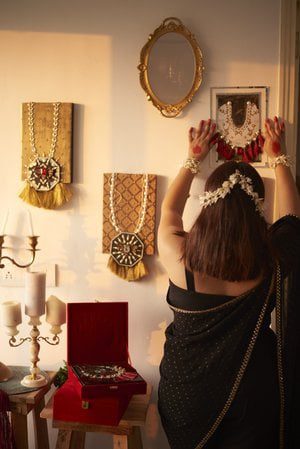
Arts to Hearts Podcast is a show delving into the lives and passions of renowned artists. From running creative businesses and studio art practices to cultivating a successful mindset, Charuka Arora engages in heartfelt conversations with her guests. Experience your personal happy hour with your favorite artists right in your studio.
Through candid discussions, Charuka and her guests reveal the joys and challenges of a vibrant creative life, both within and beyond our studios. Get ready to be inspired and uplifted as you tune in.
Liz Andrews

Liz Andrews is an artist, curator, museum professional, and leader who is dedicated to the arts and social justice. She has worked with arts organizations across the nation. In 2021, Liz began her role as Executive Director of the Spelman College Museum of Fine Art, the only museum in the nation dedicated to art by and about Black women. In her role, she has successfully curated and mounted five exhibitions, secured numerous grants, created opportunities for students to learn about art and conservation, and spearheaded the first national touring exhibition of works from the Spelman collection.
Prior to joining Spelman College, Liz Andrews was Executive Administrator in the Director’s Office of LACMA, where she expanded her role to collaborate on projects and priorities across museum departments, including diversity and inclusion efforts and curating exhibitions. Her curatorial projects at LACMA included The Obama Portraits Tour and a companion exhibition, Black American Portraits, and she commissioned an augmented reality (AR) monument dedicated to Biddy Mason by the artist Ada Pinkston, among other projects. Liz’s career is also defined by a long-standing commitment to engaging college students through research and the arts through teaching at George Mason University, serving as an advisor, and organizing public programming at the NYU Tisch School of the Arts.
Liz was born and raised in Denver, Colorado, and attributes her commitment to justice to her father, attorney Irving P. Andrews. She holds a B.A. in American Studies from Wesleyan University, an M.A. in Arts Politics from the NYU Tisch School of Arts, and a Ph.D in Cultural Studies from George Mason University, where she was honored as one of the Community & Catalysts distinguished alumni in November 2023. Her dissertation was entitled Envisioning President Barack Obama.
Liz Andrews is an artist, curator, museum professional, and leader who is dedicated to the arts and social justice. She has worked with arts organizations across the nation. In 2021, Liz began her role as Executive Director of the Spelman College Museum of Fine Art, the only museum in the nation dedicated to art by and about Black women. In her role, she has successfully curated and mounted five exhibitions, secured numerous grants, created opportunities for students to learn about art and conservation, and spearheaded the first national touring exhibition of works from the Spelman collection.
Prior to joining Spelman College, Liz Andrews was Executive Administrator in the Director’s Office of LACMA, where she expanded her role to collaborate on projects and priorities across museum departments, including diversity and inclusion efforts and curating exhibitions. Her curatorial projects at LACMA included The Obama Portraits Tour and a companion exhibition, Black American Portraits, and she commissioned an augmented reality (AR) monument dedicated to Biddy Mason by the artist Ada Pinkston, among other projects. Liz’s career is also defined by a long-standing commitment to engaging college students through research and the arts through teaching at George Mason University, serving as an advisor, and organizing public programming at the NYU Tisch School of the Arts.
Liz was born and raised in Denver, Colorado, and attributes her commitment to justice to her father, attorney Irving P. Andrews. She holds a B.A. in American Studies from Wesleyan University, an M.A. in Arts Politics from the NYU Tisch School of Arts, and a Ph.D in Cultural Studies from George Mason University, where she was honored as one of the Community & Catalysts distinguished alumni in November 2023. Her dissertation was entitled Envisioning President Barack Obama.
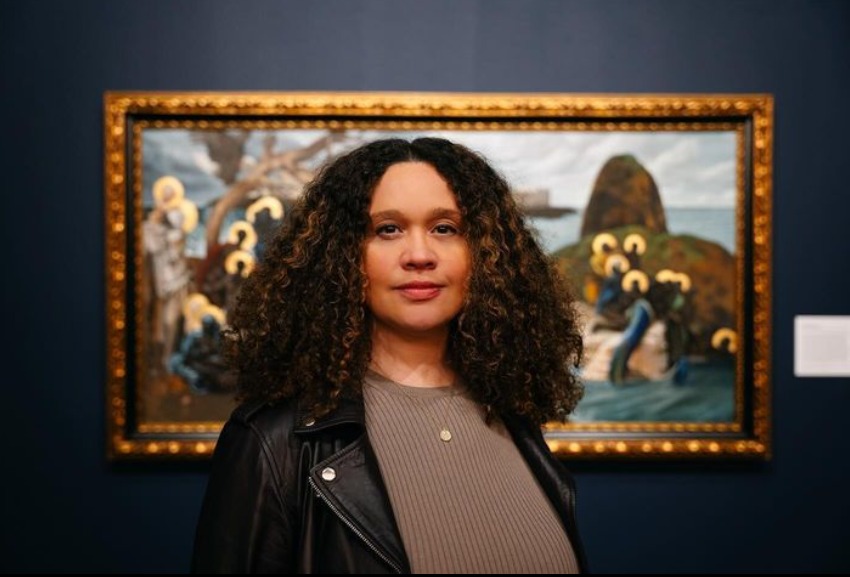
Art is a powerful way to connect with our past, reclaim our cultural identity, and preserve history. In a world where art is often seen through the lens of commercial success, the conversation between Charuka Arora and Liz Andrews reminds us of its deeper, more transformative potential. Their discussion touches on themes of loss, identity, and cultural representation, highlighting how art intersects with life, history, and personal experience.
Reclaiming Cultural Identity Through Art
Art’s link to cultural identity is a key theme throughout this conversation. For Charuka and Liz, art is more than just a way to express themselves—it’s a way to reconnect with their heritage. Charuka reflects on Indian mythology and how Western influences sometimes overshadow native cultures, leading to a loss of authentic identity. She says:
“We’ve been influenced by the West a lot, and as a colonized country, we absorbed so much of British culture. The original essence of who we were as a culture has evolved.”
Liz shares a similar experience, focusing on African mythology and the importance of reclaiming stories that colonialism tried to erase. She adds:
“It took a lot of courage to curate an exhibition focused on African religion at the historically Christian Spelman College Museum of Fine Art.”
Their conversation highlights the significance of artists like Bisa Butler, who use their work to reclaim and elevate Black identities. Andrews’ efforts, from working with artists to curating exhibitions with cultural depth, show how art can recover lost histories and amplify marginalized voices.
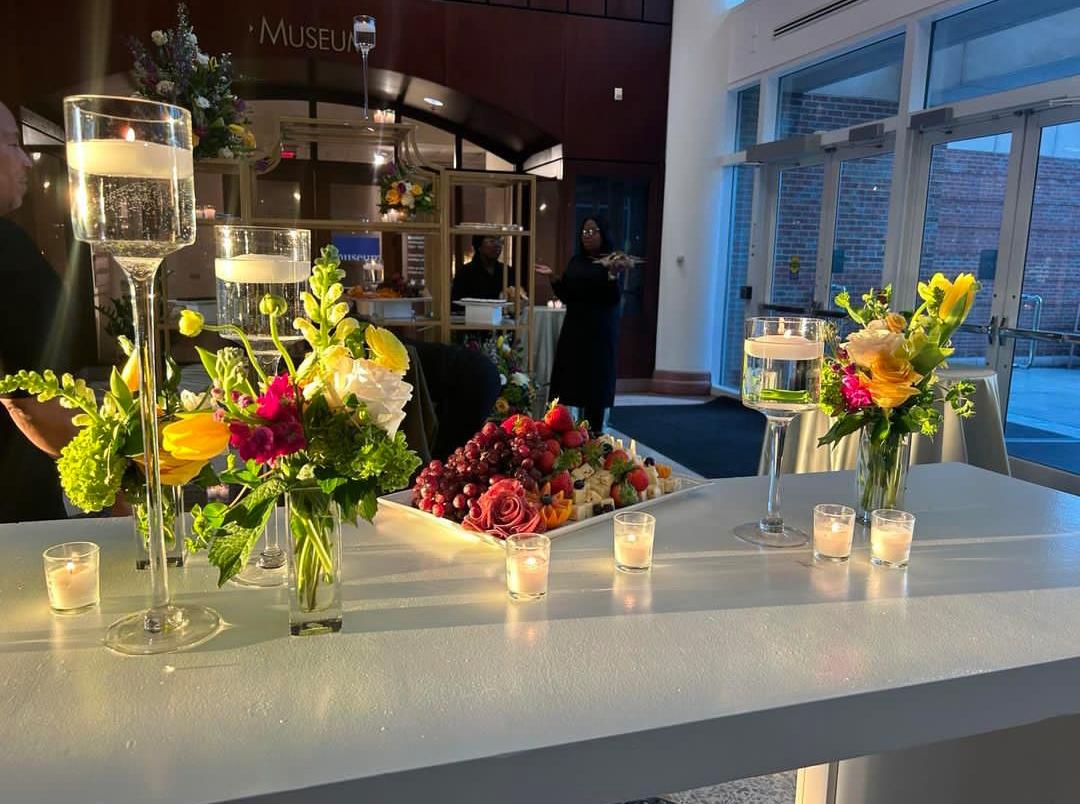
The Role of Vulnerability in Art
Vulnerability is a key aspect of both creating and curating art. Andrews talks about the challenge of balancing her roles as an artist and a curator. She candidly admits:
“I’ve been neglecting myself as an artist because I’ve been focused on supporting others.”
This statement reflects a common struggle among artists—balancing personal creativity with supporting the broader art community. Charuka expands on this idea, explaining how taking on multiple roles in the arts involves constantly balancing different parts of one’s identity. She shares:
“If I’m passionate about what I do and I want to expand that, I love the arts, supporting the arts, and engaging with people in the arts. It’s more than just one role as an artist.”
These insights highlight the importance of authenticity in art. Whether through Armonia Rosales’ reinterpretations of African deities or Lava Thomas’ powerful portraits of women from the Montgomery bus boycott, the vulnerability in these works invites viewers to connect on a deeper level.
I’d say investing in yourself as an artist as far as time and materials and making sure that you’re making things that make sense for you.
liz Andrews-Arts to Hearts podcast s04e29
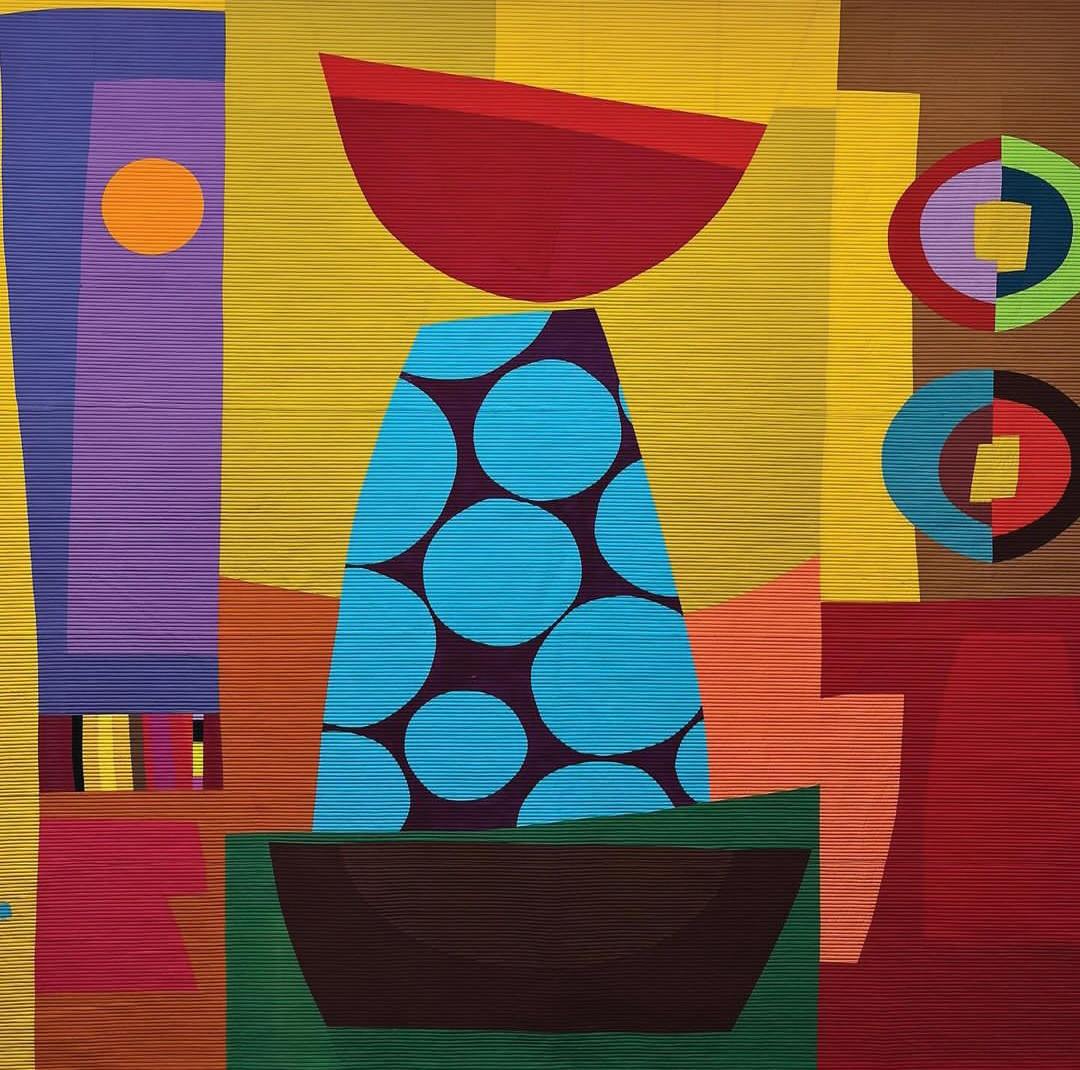
How Museums Elevate Underrepresented Voices
Museums are critical in making art accessible and amplifying voices that might otherwise go unheard. Andrews emphasizes the unique mission of Spelman College Museum of Fine Art:
“It’s the only museum in the nation dedicated to art by and about women of the African diaspora. It’s truly a gem.”
This mission is evident in the museum’s dynamic exhibitions, which showcase not only exceptional art but also rich stories. Lava Thomas’ series of pencil drawings based on mugshots of women involved in the Montgomery bus boycott is a perfect example of how museums blend artistic skill with powerful narratives.
Andrews explains:
“She has a God-given gift that she’s sharing with the world. And she’s using it to remind us that the Montgomery bus boycott and the civil rights movement were more than just male leaders and sound bites—it was organized and driven by women.”
Similarly, the exhibition of Harmony Rosales’ work at Spelman, even when it could have clashed with the school’s Christian heritage, demonstrates the museum’s commitment to exposing visitors to diverse stories and sparking cultural discussions. Rosales’ paintings, inspired by African mythology, not only showcase artistic mastery but also promote deeper cultural understanding.
These are, and in addition to that, a lot of the times when you see images of these gods in the Caribbean, especially, they’re very fair skinned like myself.
liz Andrews- Arts to Hearts podcast s04e29
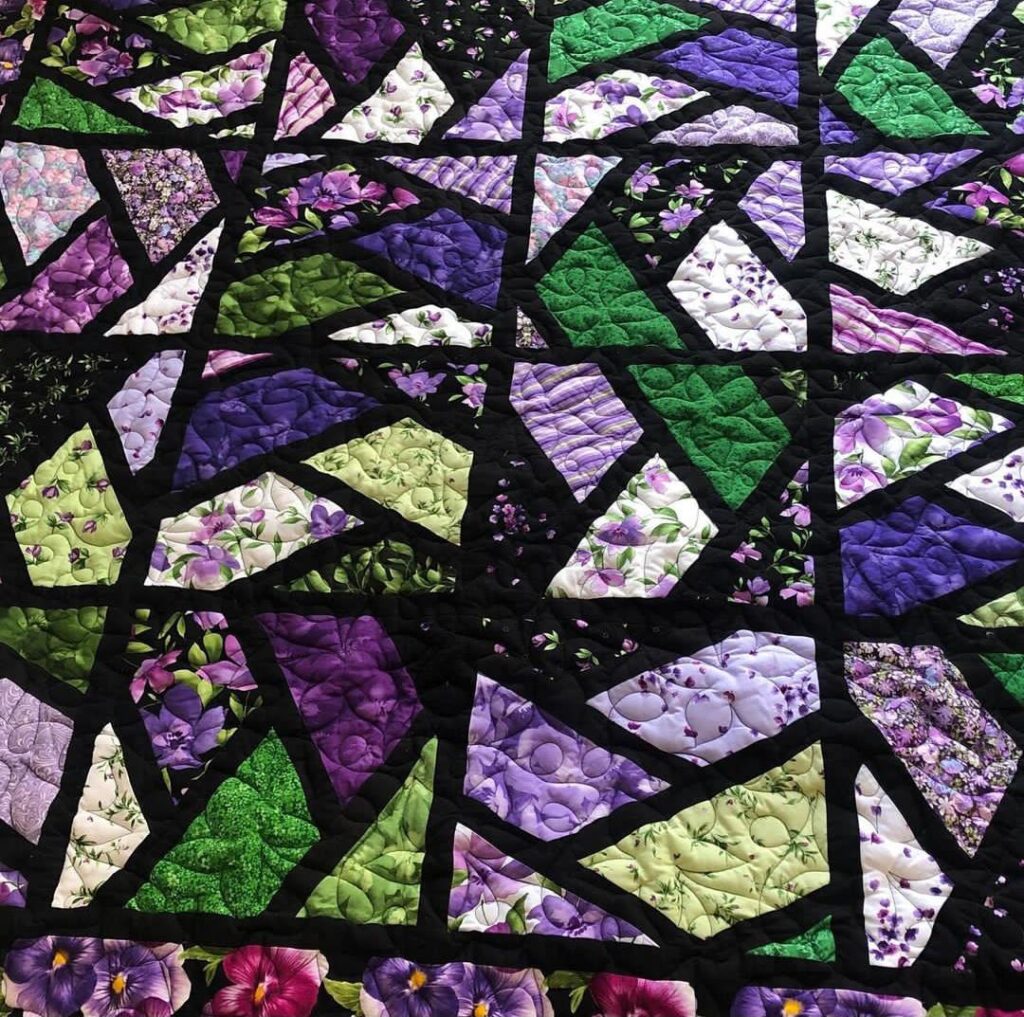
Art is more than just a collection of beautiful works; it’s a time capsule that captures, preserves, and sometimes resurfaces forgotten or overlooked histories. Through the works of artists like Bisa Butler, Lava Thomas, and Harmony Rosales, museums become more than just places to view art—they become spaces where cultural identities are celebrated, and historical narratives are reclaimed.
By focusing on these cultural stories, Andrews and her team ensure these narratives continue to educate, inspire, and provoke thought for future generations. As an artist, curator, and advocate, Andrews embodies what makes art so important: its ability to transcend time, evoke powerful emotions and challenge us to see the world from different perspectives.
You can contact Liz Andrews on her Instagram handle or visit her website for more details about her work.
To read more about the Arts to Hearts Podcast and its episodes, click here.
Listen to this & other episodes on




